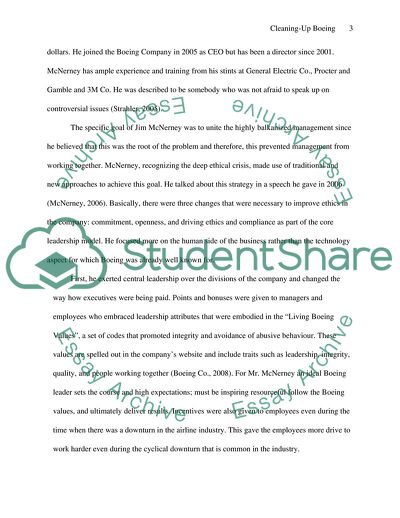
- Home
- Free Samples
- Premium Essays
- Editing Services
- Extra Tools
- Essay Writing Help
- About Us
- Studentshare
- Subjects
- Miscellaneous
- Cleaning Up Boeing
Cleaning Up Boeing - Essay Example
In 1997, Boeing merged with the McDonnell Douglas…

- Subject: Miscellaneous
- Type: Essay
- Level: Masters
- Pages: 4 (1000 words)
- Downloads: 0
- Author: meaghan34
Extract of sample "Cleaning Up Boeing"
the merger had a more damaging effect to the organization: coming from two different cultures, the newly merged company’s top echelon engaged in bitter in-fighting. What resulted open hostilities and fragmentation of the company at the top management level. Because of this, there were no major and united efforts towards the betterment of the company like sharing good ideas and improving costs. Everyone had his own agenda to follow. The second factor leading to the ethics problem was the “culture of silence”.
Even when people knew about the anomalies that were going on, no one spoke up. In the example given in the text, classified information from the competition was made available to everyone. This was taken for granted by everyone. Honesty was not practiced by the employees and the company. Jim McNerney, the new CEO, joined Boeing at a time when the company was deep into a series of ethics scandals that, as of the present, has already cost Boeing hundreds of millions of dollars. He joined the Boeing Company in 2005 as CEO but has been a director since 2001.
McNerney has ample experience and training from his stints at General Electric Co., Procter and Gamble and 3M Co. He was described to be somebody who was not afraid to speak up on controversial issues (Strahler, 2005). The specific goal of Jim McNerney was to unite the highly balkanized management since he believed that this was the root of the problem and therefore, this prevented management from working together. McNerney, recognizing the deep ethical crisis, made use of traditional and new approaches to achieve this goal.
He talked about this strategy in a speech he gave in 2006 (McNerney, 2006). Basically, there were three changes that were necessary to improve ethics in the company: commitment, openness, and driving ethics and compliance as part of the core leadership model. He focused more on the human side of the business rather than the technology aspect for which Boeing was already well known
...Download file to see next pages Read More
- TERMS & CONDITIONS
- PRIVACY POLICY
- COOKIES POLICY